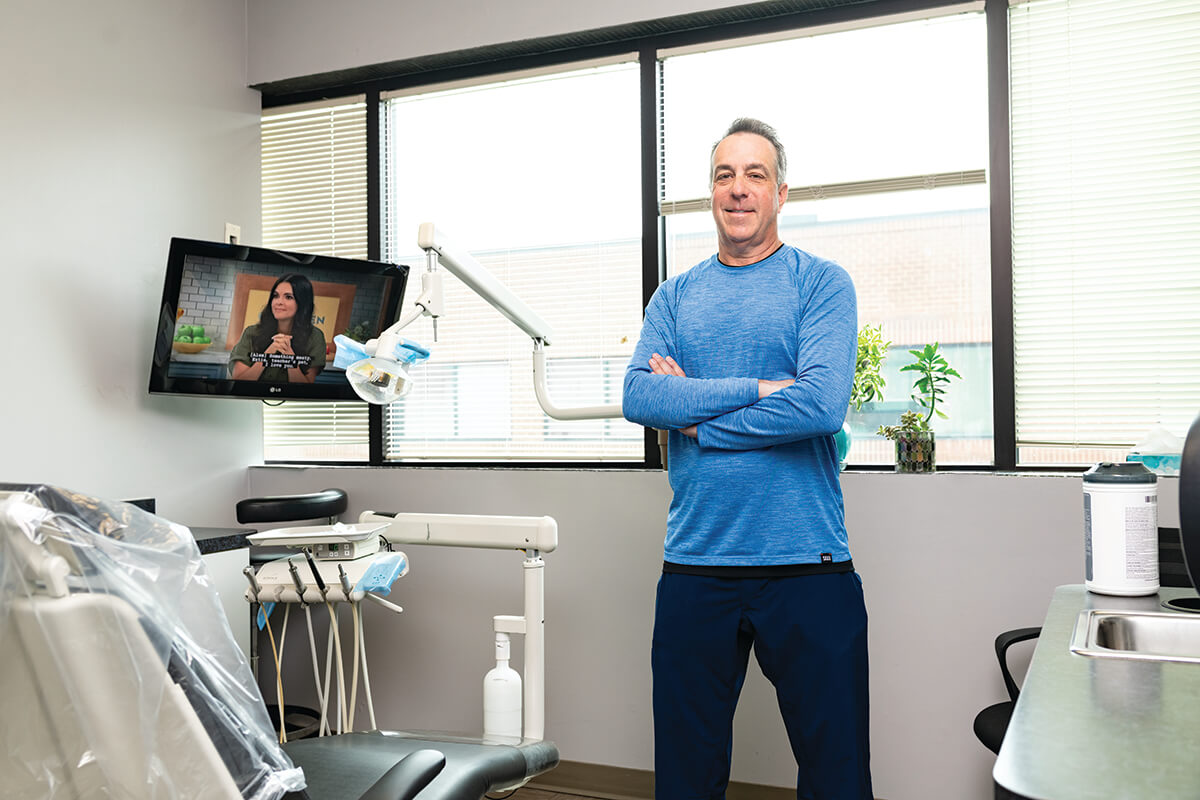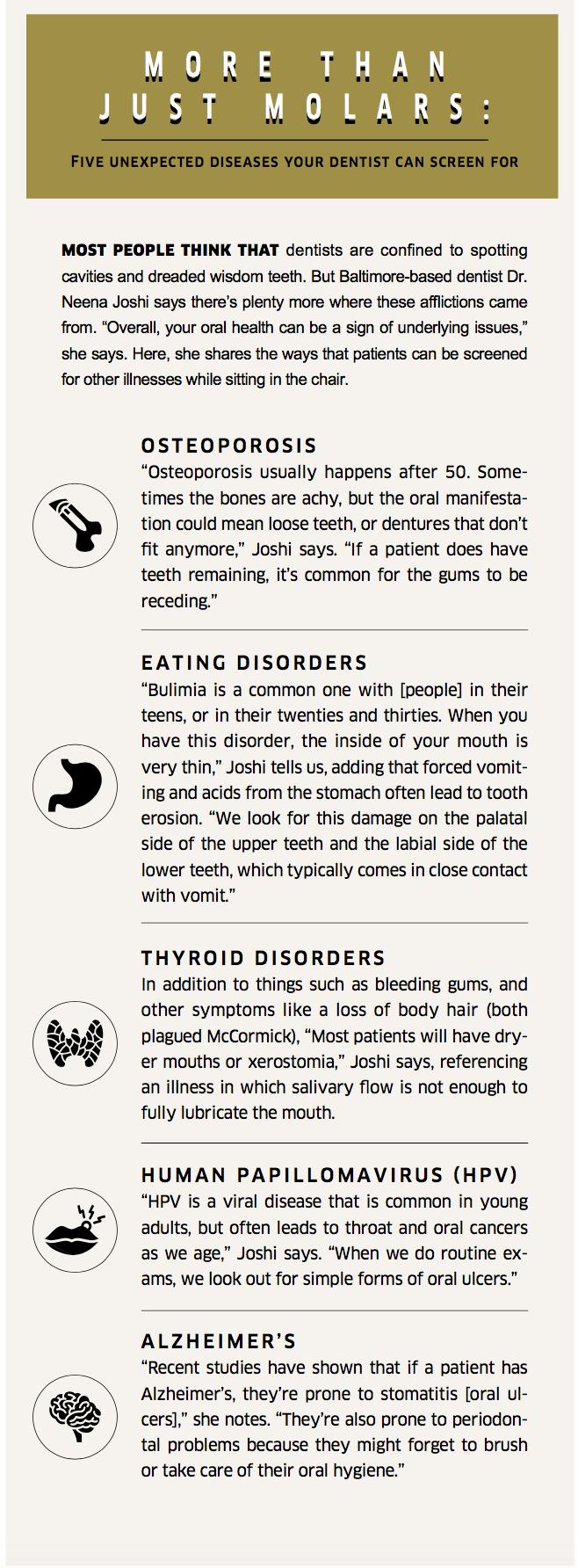Health & Wellness
Believe It or Not, The Same Person Who Polishes Your Teeth Could Save Your Life
If you need a little more incentive to return to the dentist’s chair, consider that your dentist can screen for everything from heart disease to cancer.

[Editor’s Note: This story ran as part of our Top Dentists package in the June 2022 issue. View all of the area’s Top Dentists, here.]
When title worker Jim McCormick took his 6-year-old son, Christopher, to get his first teeth cleaning, he never expected the procedure to save his life. The child was sitting on his lap, as is often recommended for a child’s first appointment, when local dentist Gary Barker stopped in his tracks.
“He looked at me and asked, ‘When was the last time that you went to see a dentist?’” McCormick says. “It had been like 15 years. I wasn’t keen on getting my teeth cleaned when I was younger.”
He wasn’t really keen on routine doctor visits either. In 1991, the then-37-year-old Pasadena dad and husband, who grew up without a dentist as a “military brat,” would smoke “a couple packs a day.” Otherwise, he was in decent shape. “I think I’d only had one headache my entire life,” he says. Still, Barker said McCormick was in rather dire need of a teeth cleaning, so in January 1992, McCormick came back—this time without Christopher in tow.
“Jim’s teeth had such bad calculus [plaque] accumulation, that the first thing that I did was clean his whole mouth,” Barker says, referring to a full mouth debridement, which is needed when plaque build-up or deposits on the teeth make it impossible to spot decay or gum disease. “His gums bled pretty heavily at first, which was something I expected.”
But when Barker called to check on him that evening, McCormick said his bleeding hadn’t stopped. When Barker found out that McCormick was still bleeding two days after the appointment, he sent him to an internist for several different blood tests—none of which could narrow down a diagnostic culprit. Within weeks, his doctors recommended that he see a cancer specialist at MedStar Harbor Hospital.
According to McCormick, “I walked into the room, and the doctor said, ‘There’s one thing I can tell you that I can’t tell the majority of my patients: You’re going to live. I think you have a thyroid problem.’”
Although very treatable, McCormick’s case was grave. Tests determined that a virus caused his thyroid to shut down almost completely, leaving him with insufficient means for blood to clot (hence the excess of oral bleeding.)
“I took a bleeding time test, where they give you a small cut using a razor blade to see how long it takes for you to clot. It’s supposed to take between two and three minutes. I was bleeding 30 minutes later,” he says. “They told me I was lucky to be alive. If I had been cut badly or had been in a car accident, I would have bled to death.”
Suffice it to say, if McCormick hadn’t gone to see Barker, he would not have known that he had this bleeding disorder until it was possibly too late. He thought he wouldn’t live to see his forties. But McCormick, now in his middle sixties, who still lives in Pasadena with his wife of 39 years, went on to see their only son grow up. He says Christopher, now married, learned a valuable lesson from his dad’s mistake: “He goes to see the dentist twice a year.”
So does his father. On top of ditching cigarettes for good, every six months, McCormick visits Dr. Barker’s office to “say ‘hi’ to everybody. And if there’s someone new on staff, I’ll tell them, ‘You’re working for a great guy. He saved my life.’ I probably wouldn’t be here if it wasn’t for him.”
DON’T FEAR THE DENTIST
Dentophobia (or fear of the dentist) is a real thing that should not be exacerbated by a concern that your practitioner is going to find some scary disease in your mouth. Such findings, while an important component of your overall health screenings, remain relatively rare, our experts assure us. So, how often should the average person go to see their dentist? In most cases, the recommended practice is every six months to a year for routine cleanings and exams—and as needed for procedures such as root canals and fillings. According to a 2020 study by the National Center for Health Statistics, 63 percent of American adults (and 85.9 percent of kids) had seen their dentist once within the last year. But what about the rest of us?
In addition to factors like staggering costs, “Fear does keep a lot of people away from the dentist,” admits Dr. George Shepley, president-elect of the American Dental Association (ADA). “But by ignoring things, they’re just going to get worse. It’s always best to practice prevention.”
Shepley says that routine dental hygiene checkups can be helpful when it comes to spotting things like gingivitis, a mild inflammation of the gums, or periodontal disease, an infection of the so tissue and bones that hold one’s teeth in place. Luckily, he says these issues tend to be quite treatable.
“Most of the time, when patients come in regularly, we see that their gums and their tissue start healing. They regain their health,” he says.
READ THE WARNING SIGNS
“But sometimes, we see patients who will still have inflammation when they start brushing and flossing. If they chronically don’t get better, we recommend they go see their physician for a physical and screening,” says Shepley. “We’re learning more and more about how inflammation affects the body systemically,” he adds, citing its correlations to conditions such as coronary artery disease, Alzheimer’s, and prostate cancer. It possibly correlates to rheumatoid arthritis as well, as research has shown that the same bacteria and inflammatory factors in gum disease can be found in the joints.
Shepley notes that inflammation, marked by swelling, irritation, bleeding, and redness in the areas where gums connect to teeth, is most prevalent in patients who show signs of diabetes. But even if you don’t have diabetes, “It’s not good for anything in terms of your health,” he says, adding, that in general, systemic inflammation “can cause heart vessels to weaken and the kidneys to become damaged.”
Another often-ignored symptom is pain. If left untreated too long, Shepley warns that even minor pain or irritation in the gums could mean infection.
“Infections are never good. In fact, serious infections in your mouth can often travel to the brain or lead to swelling in the throat, like with Ludwig’s angina, which some patients can die from,” he explains. Ludwig’s angina is a life-threatening cellulitis on the floor of the mouth that leads to difficulty swallowing.
Overall, he says the biggest indicator of infection—aside from excess warmth in local areas and symptoms of a fever—is bleeding gums, something many patients like McCormick tend to downplay.
“Some people think that when your gums bleed, it’s normal. Healthy gums should never bleed,” he stresses.
THE IMPORTANCE OF ROUTINE SCREENINGS
As far as preventable ailments that dentists can screen for, Shepley says that inflammation and bleeding are just the tip of the iceberg. “One condition I’ve been seeing in my patients all the time is sleep apnea,” he says. The disorder, which occurs when one’s breathing stops and starts throughout their sleep cycle, is dangerous, placing excess stressors on the heart.
Over the last decade, Shepley says that newer ways of spotting the condition have emerged. Symptoms he refers to as “The Holy Triad” include acid reflux—which is known to cause erosion of enamel on the molars—wheezing, snoring, and teeth grinding (which he lumps together), and narrowed airways, which are often signaled by an oddly placed or elevated tongue.
“When we become aware of those signals, we recommend that patients get checked out and undergo a sleep study,” Shepley says. However, for those facing more serious issues such as tumors, human papillomavirus (HPV), or oral cancers, key warning factors tend to be less obvious than snoring.

“Oral cancer is something very prevalent in dentistry. We’re often some of the first to diagnose it,” Shepley says of the disease, which can target lips, jaws, teeth, palates, cheeks, and several other regions near the mouth. Based on the most recent findings from The American Cancer Society, oral cancers are responsible for upward of 11,000 deaths and more than 50,000 new cases each year. According to the Oral Cancer Foundation, when left unaddressed, it poses the risk of metastasis, the spreading of a cancer from one organ to another, primarily in regions like the lymph nodes, brain, and lungs.
With cancer screenings, wherein dentists look for patches, sores, and bumps inside the mouth, Shepley says, “It’s better to be safe than sorry. I’m a big prevention guy, and oral health is crucial to your overall health. By going to the dentist regularly and practicing good preventive health dentistry, you’re going to feel empowered,” he says. “You’re going to feel better knowing that you’re doing what you can to take care of yourself.”
Baltimore-based dentist Dr. Neena Joshi echoes this, urging dental skeptics to forego the doomsday mindset when it comes to the upkeeping of their teeth and mouths.
“I’d tell any patients who are scared of the dentist, which is common, to just go for it,” she says. “It doesn’t have to be a scary visit. We can do a routine checkup, take an X-ray, check your gums, and take things one tooth at a time.”
Joshi stresses that there’s no shame in the process, and that it’s never too late to take care of one’s neglected oral hygiene.
“As clinicians, we don’t judge our patients by their oral health. We just do our part and hope they come to visit us more often.”
For his part, McCormick says he wishes that he’d learned these life-impacting lessons sooner.
“Things with my health could have been worse than what they were. After Dr. Barker cleaned my teeth, if that problem hadn’t surfaced, who knows where I would be today? Back then, I wasn’t thinking clearly.”
Thank goodness Dr. Barker was. “I’m glad that I was smart enough to follow up with Jim and say, ‘Uh-uh. This isn’t normal.’”